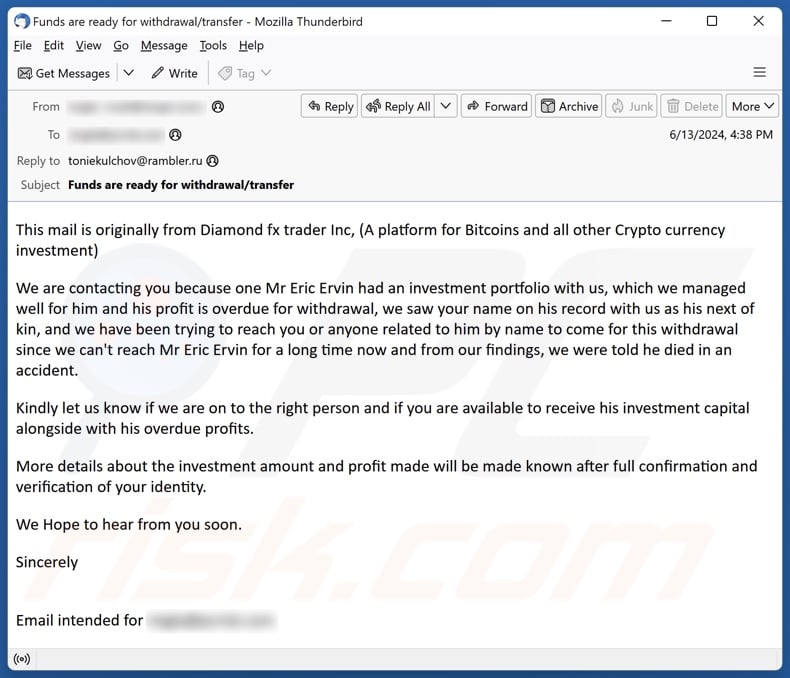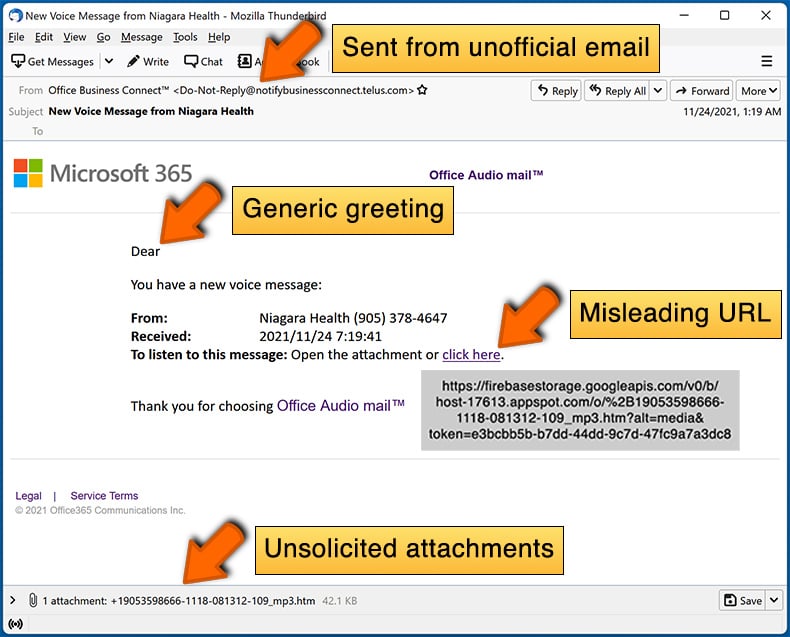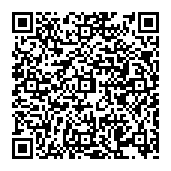Avoid getting scammed by fake "Investment Portfolio Withdrawal" emails
![]() Written by Tomas Meskauskas on
Written by Tomas Meskauskas on
What kind of email is "Investment Portfolio Withdrawal"?
Our examination of the "Investment Portfolio Withdrawal" email revealed that it is spam. This scam letter states that an investor had passed away, and their overdue portfolio lists the email recipient as the next of kin. If the recipient is the right person – they will be eligible to receive the funds.
The purpose of this scam mail is likely to trick users into disclosing sensitive information or sending money to scammers.

"Investment Portfolio Withdrawal" email scam overview
The spam email with the subject "Funds are ready for withdrawal/transfer" (may vary) states that the recipient is being contacted as their name was listed as the next of kind for a person with an investment portfolio with the sender. The profit had been long overdue for withdrawal, and the owner could not be contacted for a long time.
Information regarding the investor's death in an accident was found during a search for their close relations. The recipient is requested to confirm whether they are the person listed as next of kin. Following confirmation and identity verification, the recipient will be able to claim the late investor's investment capital and overdue profits.
As mentioned in the introduction, all the information in this email is false, and this mail is not associated with any real public figures, legitimate investment platforms, or other genuine entities.
How the scam promoted by this spam email progresses may vary. Typically, scammers utilize such lures to acquire private information or funds directly.
Since the "Investment Portfolio Withdrawal" email mentions "verification of your identity", that does suggest that the scammers will ask for personal details (e.g., name, age, gender, occupation, marital status, home and work addresses, contact info, etc.). Information of this kind can be used for a variety of nefarious purposes, not the least of which being identity theft.
Additionally, schemes of this kind may request victims to make bogus payments, such as paying transaction fees, handling taxes, etc. Scammers prefer difficult-to-trace methods for acquiring money, e.g., cryptocurrencies, gift cards, pre-paid vouchers, cash hidden in packages and shipped, and so forth. By relying on these methods, cyber criminals minimize the chances of successful prosecution and fund retrieval by victims.
To summarize, by trusting an email like "Investment Portfolio Withdrawal" – users can experience severe privacy issues, financial losses, and identity theft.
If you have already disclosed personally identifiable or finance-related information to scammers – immediately contact the appropriate authorities.
| Name | "Investment Portfolio Withdrawal" spam email |
| Threat Type | Phishing, Scam, Social Engineering, Fraud |
| Fake Claim | The recipient is listed as a late investor's next of kin. |
| Symptoms | Unauthorized online purchases, changed online account passwords, identity theft, illegal access of the computer. |
| Distribution methods | Deceptive emails, rogue online pop-up ads, search engine poisoning techniques, misspelled domains. |
| Damage | Loss of sensitive private information, monetary loss, identity theft. |
| Malware Removal (Windows) | To eliminate possible malware infections, scan your computer with legitimate antivirus software. Our security researchers recommend using Combo Cleaner. |
Spam campaigns in general
We have investigated countless spam campaigns; "2026 FIFA World Cup Lottery", "Webmail - Confirm Domain Ownership", "Bank Account Details", 'WebRoot Security Services Activated", "AT&T", "PayPal Confirmation Notification", "Specification For The Item Requested", and "Products We Want To Purchase" are just some of our newest articles on this topic.
Spam is used to facilitate various scams, including phishing, sextortion, advance fee, lottery, tech support, refund, and so on. Additionally, this mail is used to proliferate malware.
While the commonly held belief that spam emails are shoddily put together and rife with grammatical/spelling errors is not untrue, it is not always the case. These letters can be competently made and even believably disguised as messages from legitimate entities (e.g., companies, service providers, institutions, authorities, etc.).
How do spam campaigns infect computers?
Cyber criminals commonly use spam campaigns to distribute malware. Deceptive emails/messages can have malicious files attached to or linked inside them. These files come in various formats, e.g., documents (Microsoft Office, Microsoft OneNote, PDF, etc.), archives (ZIP, RAR, etc.), executables (.exe, .run, etc.), JavaScript, and so forth.
Merely opening an infectious file can be enough to trigger malware download/installation. However, some formats need additional user interaction to jumpstart system infection processes. For example, Microsoft Office files require users to enable macro commands (i.e., editing/content), while OneNote documents need them to click embedded links or files.
How to avoid installation of malware?
It is important to always approach incoming emails and other messages with caution. Attachments or links found in dubious/irrelevant mail must not be opened, as they can be harmful or infectious.
It must be mentioned that malware is not distributed exclusively via spam mail. Therefore, we recommend being careful while browsing, as fraudulent and malicious online content typically appears genuine and harmless.
Additionally, all downloads must be made from official and verified sources. We also advise activating and updating programs by using legitimate functions/tools, as illegal activation ("cracking") tools and third-party updates can contain malware.
We must stress the importance of having a reputable anti-virus installed and kept updated. Security software must be used to perform regular system scans and to remove detected threats and issues. If you've already opened malicious attachments, we recommend running a scan with Combo Cleaner Antivirus for Windows to automatically eliminate infiltrated malware.
Text presented in the "Investment Portfolio Withdrawal" spam email letter:
Subject: Funds are ready for withdrawal/transfer
This mail is originally from Diamond fx trader Inc, (A platform for Bitcoins and all other Crypto currency investment)
We are contacting you because one Mr Eric Ervin had an investment portfolio with us, which we managed well for him and his profit is overdue for withdrawal, we saw your name on his record with us as his next of kin, and we have been trying to reach you or anyone related to him by name to come for this withdrawal since we can't reach Mr Eric Ervin for a long time now and from our findings, we were told he died in an accident.
Kindly let us know if we are on to the right person and if you are available to receive his investment capital alongside with his overdue profits.
More details about the investment amount and profit made will be made known after full confirmation and verification of your identity.
We Hope to hear from you soon.
Sincerely
Email intended for -
Instant automatic malware removal:
Manual threat removal might be a lengthy and complicated process that requires advanced IT skills. Combo Cleaner is a professional automatic malware removal tool that is recommended to get rid of malware. Download it by clicking the button below:
▼ DOWNLOAD Combo Cleaner
By downloading any software listed on this website you agree to our Privacy Policy and Terms of Use. To use full-featured product, you have to purchase a license for Combo Cleaner. 7 days free trial available. Combo Cleaner is owned and operated by Rcs Lt, the parent company of PCRisk.com read more.
Quick menu:
- What is "Investment Portfolio Withdrawal" spam email?
- Types of malicious emails.
- How to spot a malicious email?
- What to do if you fell for an email scam?
Types of malicious emails:
![]() Phishing Emails
Phishing Emails
Most commonly, cybercriminals use deceptive emails to trick Internet users into giving away their sensitive private information, for example, login information for various online services, email accounts, or online banking information.
Such attacks are called phishing. In a phishing attack, cybercriminals usually send an email message with some popular service logo (for example, Microsoft, DHL, Amazon, Netflix), create urgency (wrong shipping address, expired password, etc.), and place a link which they hope their potential victims will click on.
After clicking the link presented in such email message, victims are redirected to a fake website that looks identical or extremely similar to the original one. Victims are then asked to enter their password, credit card details, or some other information that gets stolen by cybercriminals.
![]() Emails with Malicious Attachments
Emails with Malicious Attachments
Another popular attack vector is email spam with malicious attachments that infect users' computers with malware. Malicious attachments usually carry trojans that are capable of stealing passwords, banking information, and other sensitive information.
In such attacks, cybercriminals' main goal is to trick their potential victims into opening an infected email attachment. To achieve this goal, email messages usually talk about recently received invoices, faxes, or voice messages.
If a potential victim falls for the lure and opens the attachment, their computers get infected, and cybercriminals can collect a lot of sensitive information.
While it's a more complicated method to steal personal information (spam filters and antivirus programs usually detect such attempts), if successful, cybercriminals can get a much wider array of data and can collect information for a long period of time.
![]() Sextortion Emails
Sextortion Emails
This is a type of phishing. In this case, users receive an email claiming that a cybercriminal could access the webcam of the potential victim and has a video recording of one's masturbation.
To get rid of the video, victims are asked to pay a ransom (usually using Bitcoin or another cryptocurrency). Nevertheless, all of these claims are false - users who receive such emails should ignore and delete them.
How to spot a malicious email?
While cyber criminals try to make their lure emails look trustworthy, here are some things that you should look for when trying to spot a phishing email:
- Check the sender's ("from") email address: Hover your mouse over the "from" address and check if it's legitimate. For example, if you received an email from Microsoft, be sure to check if the email address is @microsoft.com and not something suspicious like @m1crosoft.com, @microsfot.com, @account-security-noreply.com, etc.
- Check for generic greetings: If the greeting in the email is "Dear user", "Dear @youremail.com", "Dear valued customer", this should raise suspiciousness. Most commonly, companies call you by your name. Lack of this information could signal a phishing attempt.
- Check the links in the email: Hover your mouse over the link presented in the email, if the link that appears seems suspicious, don't click it. For example, if you received an email from Microsoft and the link in the email shows that it will go to firebasestorage.googleapis.com/v0... you shouldn't trust it. It's best not to click any links in the emails but to visit the company website that sent you the email in the first place.
- Don't blindly trust email attachments: Most commonly, legitimate companies will ask you to log in to their website and to view any documents there; if you received an email with an attachment, it's a good idea to scan it with an antivirus application. Infected email attachments are a common attack vector used by cybercriminals.
To minimise the risk of opening phishing and malicious emails we recommend using Combo Cleaner Antivirus for Windows.
Example of a spam email:

What to do if you fell for an email scam?
- If you clicked on a link in a phishing email and entered your password - be sure to change your password as soon as possible. Usually, cybercriminals collect stolen credentials and then sell them to other groups that use them for malicious purposes. If you change your password in a timely manner, there's a chance that criminals won't have enough time to do any damage.
- If you entered your credit card information - contact your bank as soon as possible and explain the situation. There's a good chance that you will need to cancel your compromised credit card and get a new one.
- If you see any signs of identity theft - you should immediately contact the Federal Trade Commission. This institution will collect information about your situation and create a personal recovery plan.
- If you opened a malicious attachment - your computer is probably infected, you should scan it with a reputable antivirus application. For this purpose, we recommend using Combo Cleaner Antivirus for Windows.
- Help other Internet users - report phishing emails to Anti-Phishing Working Group, FBI’s Internet Crime Complaint Center, National Fraud Information Center and U.S. Department of Justice.
Frequently Asked Questions (FAQ)
Why did I receive this email?
Spam emails are not personal, even if they include details relevant to the recipients. Cyber criminals distribute this mail in large-scale operations with the hopes that at least some recipients will fall for their scams.
I have provided my personal information when tricked by this spam email, what should I do?
If you have provided your log-in credentials – change the passwords of all possibly exposed accounts and inform their official support without delay. However, if the disclosed information was of a different personal nature (e.g., ID card details, passport scans/photos, credit/debit card numbers, etc.) – immediately contact relevant authorities.
I have read a spam email but didn't open the attachment, is my computer infected?
Reading an email poses no infection threat. Devices are compromised when malicious attachments or links are opened/clicked.
I have downloaded and opened a file attached to a spam email, is my computer infected?
If the opened file was an executable (.exe, .run, etc.) – most likely, yes – your system was infected. However, you might have avoided this if it was a document (.doc, .xls, .one, .pdf, etc.). Some formats need additional actions to begin downloading/installing malware (e.g., enabling macro commands, clicking embedded content, etc.).
Will Combo Cleaner remove malware infections present in email attachments?
Yes, Combo Cleaner is designed to scan computers and eliminate all kinds of threats. It can detect and remove most of the known malware infections. Keep in mind that performing a full system scan is essential since sophisticated malicious programs typically hide deep within systems.


▼ Show Discussion